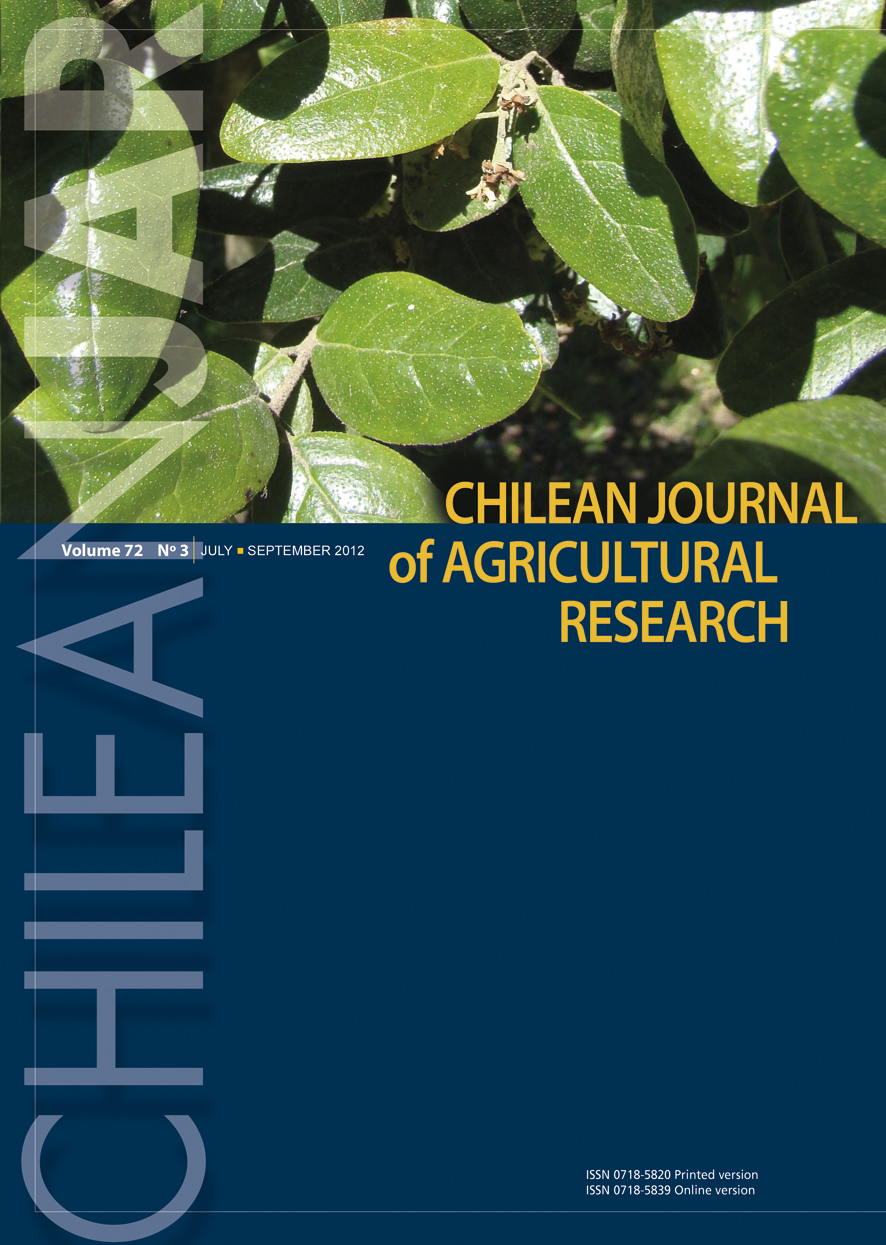
|
Chilean Journal of Agricultural Research
Instituto de Investigaciones Agropecuarias, INIA
ISSN: 0718-5820
EISSN: 0718-5820
Vol. 68, No. 4, 2008, pp. 352-359
|
 Bioline Code: cj08037
Bioline Code: cj08037
Full paper language: English
Document type: Research Article
Document available free of charge
|
|
|
Chilean Journal of Agricultural Research, Vol. 68, No. 4, 2008, pp. 352-359
| en |
Prediction of the chemical composition and fermentation parameters of pasture silage by near infrared reflectance spectroscopy (NIRS)
Ibáñez, Lorena & Alomar, Daniel
Abstract
The capability of near infrared reflectance spectroscopy (NIRS) was evaluated to predict the content of total ash (TA), crude protein (CP), crude fiber (CF), neutral detergent fiber (NDF), acid detergent fiber (ADF) and metabolizable energy (ME); as well as pH and ammonia nitrogen content (N-NH3), in pasture silage, with and without additives. Nine hundred and twenty dried and ground samples of pasture silage, with known chemical composition, were scanned over the visible and NIR region (400 to 2500 nm) at 2 nm intervals. Calibration equations were developed by modified partial least square regression models (MPLS) with different mathematical treatments and light scatter correction as standard normal variation and Detrend (SNV & D) of the spectra. For each parameter, the optimum calibration was evaluated on the basis of the cross validation determination coefficient (1-VR) and standard error of cross validation (SECV). NIRS showed a high predictive ability, with 1-VR > 0.89 and SECV (%) of 5.14, 6.69, 9.96, 16.01 and 9.15 for A, CP, CF, NDF and ADF, respectively. NIRS showed moderate accuracy for ME, with 1-VR > 0.87, SECV: 0.07Mcal kg-1 and low accuracy, although with feasibility as a ranking method, for pH and N-NH3, with 1-VR > 0.72 and SECV of 0.14 and 1.49, respectively. It is concluded that the equations obtained can be used to predict the nutritional composition of pasture silages.
Keywords
nutritional composition, silage, pasture, spectroscopy, NIRS.
|
| |
| es |
Predicción de la composición química y parámetros fermentativos de ensilajes de pradera mediante espectroscopía de reflectancia en el infrarrojo cercano (NIRS).
Ibáñez, Lorena & Alomar, Daniel
Resumen
Se evaluó la capacidad de la espectroscopía de reflectancia en el infrarrojo cercano (NIRS) para predecir la composición química: cenizas totales (CT), proteína cruda (PC), fibra cruda (FC), fibra detergente neutro (FDN), fibra detergente ácido (FDA), energía metabolizable (EM) y parámetros fermentativos: pH y nitrógeno amoniacal (N-NH3), en ensilajes de pradera con y sin aditivos. Se tomaron espectros (400 a 2500 nm, cada 2 nm) de muestras secas y molidas (n = 920) de ensilajes de pradera con composición química conocida. Se desarrollaron calibraciones evaluando diferentes tratamientos matemáticos del espectro y corrección de dispersión de luz como la variación normal estándar y Detrend (SNV & D) y se ajustaron ecuaciones de predicción mediante regresión de cuadrados mínimos parciales modificados (MPLS). Las mejores ecuaciones se seleccionaron considerando el coeficiente de determinación (1-VR) y el error estándar (SECV), obtenidos en una validación cruzada. NIRS mostró alta capacidad predictiva con 1-VR > 0,89 y SECV (%) de 5,14; 6,69; 9,96; 16,01 y 9,15 para CT, PB, FC, FDN y FDA, respectivamente. La confiabilidad fue razonable para EM, con 1-VR > 0,87 y SECV de 0,07 Mcal kg-1; y poco confiable, pero con posibilidad de uso en clasificación por rangos, para pH y N-NH3, con 1-VR > 0,72 y SECV de 0,14 y 1,49%, respectivamente. Se concluyó que las ecuaciones obtenidas pueden ser usadas para predecir la composición nutricional de ensilajes de pradera.
Palabras-clave
composición nutricional, ensilaje, pradera, espectroscopía, NIRS.
|
| |
© Copyright 2008 - Instituto de Investigaciones Agropecuarias, INIA (Chile).
Alternative site location: http://www.inia.cl
|
|
